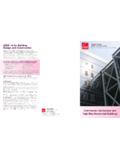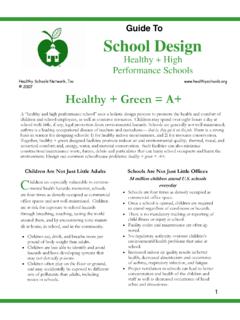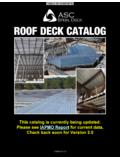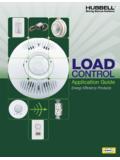Transcription of LEED BD+C v4 Credit Summary Sheet - Lori's Web
1 1 INTEGRATIVE PROCESS (IP)LEED BD+C v4 Credit Summary SheetNAMEINTENTREQUIREMENTSADDITIONAL INFORMATIONSTANDARDSEXEMPLARY PERFORMANCEPI ntegrative Project Planning and DesignHCMaximize opportunities for integrated, cost-effective adoption of green design and construction strategies, emphasizing human health as a fundamental evaluative criterion for building design , construction and operational strategies. Utilize innovative approaches and techniques for green design and cross-discipline design and decision making, beginning in the programming and pre- design phase. At a minimum, ensure the following process:Owner s Project Requirements DocumentPrepare an Owner s Project Requirements (OPR) document. Develop a health mission statement and incorporate it in the OPR. The health mission statement must address "triple bottom line" values economic, environmental and social. Include goals and strategies to safeguard the health of building occupants, the local community and the global environment, while creating a high-performance healing environment for the building s patients, caregivers and Rating GoalsAs early as practical and preferably before schematic design , conduct a preliminary LEED meeting with a minimum of four key project team members and the owner or owner s representative.
2 As part of the meeting, create a LEED action plan that, at a minimum: Determines the LEED certification level to pursue (Certified, Silver, Gold, or Platinum); Selects the LEED credits to meet the targeted certification level; and Identifies the responsible parties to ensure the LEED requirements for each prerequisite and selected Credit are Project TeamAssemble an integrated project team and include as many of the following professionals as feasible (minimum of four), in addition to the owner or owner s CharretteAs early as practical and preferably before schematic design , conduct a minimum four-hour , integrated design charrette with the project team as defined above. The goal is to optimize the integration of green strategies across all aspects of building design , construction and operations, drawing on the expertise of all Bottom Line - People, Planet, ProfitA comprehensive, integrative process accounts for the interactions of all building and site systems, relying on an iterative cycle of analysis, workshops, implementation, and performance s project requirements (OPR) a written document that details the ideas, concepts, and criteria determined by the owner to be important to the success of the of design (BOD) the information necessary to accomplish the owner s project requirements, including system descriptions, indoor environmental quality criteria, design assumptions, and references to applicable codes, standards, regulations, and Consensus National Standard Guide for design and Construction of Sustainable Buildings and Communities (February 2, 2012)
3 N/ACIntegrative ProcessNC, CS, S, R, DC, WDC, HOS, HCTo support high performance, cost-effective project outcomes throughan early analysis of the interrelationships among SystemsDiscoveryPerform a preliminary simple box energy modeling analysis before the completion of schematic design that explores how to reduce energy loads in the building and accomplish related sustainability goals by questioning default assumptions. Assess at least two potential strategies associated with the following: Site conditions. Assess shading, exterior lighting, hardscape, landscaping, and adjacent site conditions. Massing and orientation. Assess how massing and orientation affect HVAC sizing, energy consumption, lighting, and renewable energy opportunities. Basic envelope attributes. Assess insulation values, window-to-wall ratios, glazing characteristics, shading, and window operability. Lighting levels. Assess interior surface reflectance values and lighting levels in occupied spaces. Thermal comfort ranges.
4 Assess thermal comfort range options. Plug and process load needs. Assess reducing plug and process loads through programmatic solutions ( , equipment and purchasing policies, layout options). Programmatic and operational parameters. Assess multifunctioning spaces, operating schedules, space allotment per person, teleworking, reduction of building area, and anticipated operations and how the above analysis informed design and building form decisions in the project s OPR and BOD and the eventual design of the projectWater-Related SystemsDiscoveryPerform a preliminary water budget analysis before the completion of schematic design that explores how to reduce potable water loads in the building and accomplish related sustainability goals. Assess and estimate the project s potential nonpotable water supply sources and water demand volumes, including the following: Indoor water demand. Assess flow and flush fixture design case demand volumes, calculated in accordance with WE Prerequisite Indoor Water-Use Reduction.
5 Outdoor water demand. Assess landscape irrigation design case demand volume calculated in accordance with WE Credit Outdoor Water-Use Reduction. Process water demand. Assess kitchen, laundry, cooling tower, and other equipment demand volumes, as applicable. Supply sources. Assess all potential nonpotable water supply source volumes, such as on-site rainwater and graywater, municipally supplied nonpotable water, and HVAC equipment condensateImplementationDocument how the above analysis informed building and site design decisions in the project s OPR and BOD. Demonstrate how at least one on-site nonpotable water supply source was used to reduce the burden on municipal supply or wastewater treatment systems by contributing to at least two of the water demand components listed Process1. Discovery2. design and Construction3. Occupancy, operations, and performance feedbackANSI Consensus National Standard Guide for design and Construction of Sustainable Buildings and Communities (February 2, 2012)No2 LOCATION AND TRANSPORTATION (LT)LEED BD+C v4 Credit Summary SheetNAMEINTENTREQUIREMENTSADDITIONAL INFORMATIONSTANDARDSEXEMPLARY PERFORMANCECLEED for Neighborhood Development LocationNC, CS, S, R, DC, WDC, HOS, HCTo avoid development on inappropriate sites.
6 To reduce vehicles miles traveled. To enhance livability and improve human health by encouraging daily physical the project within the boundary of a LEED ND certified attempting this Credit are not eligible to earn points under other Location and Transportation or 2009 - Stage 2 or Stage 3 LEED v4 - Certified Plan or Certified ProjectPoint total increases with LEED ND certification level - Certified, Silver, Gold LEED BD+C - 8 pts, 10 pts, 12 pts, 16 ptsLEED ND - walkability, transit access, sensitive land protection, connectivity, and shared website for up-to-date lists of LEED ND projectsLEED ND project information (name, ID number, rating system and version, certification level, and certification date)Vicinity base map with LEED project boundary and LEED ND certified neighborhood or plan boundaryNoneNoCSensitive Land ProtectionNC, CS, S, R, DC, WDC, HOS, HCTo avoid the development of environmentally sensitive lands and reduce the environmental impact from the location of a building on a 1.
7 Locate development footprint on previously developed 2. If development footprint is on previously undeveloped land, avoid:Prime farmlandsFloodplainsHabitat100 ft from a water body, minor improvements are okay50 feet from a Wetlands, minor improvements are okayMinor ImprovementsBicycle and pedestrian pathways 12 feet wide, of which no more than 8 feet may be impervious;Activities to maintain or restore native natural communities and/or natural hydrology;One single-story structure per 300 linear feet on average, not exceeding 500 square feet;Grade changes necessary to ensure public access;Clearings, limited to one per 300 linear feet on average, not exceeding 500 square feet each;Removal of the following tree types:Hazardous trees, up to 75% of dead trees; Trees less than 6 inches diameter at breast height; Up to 20% of trees more than 6 inches diameter at breast height with a condition rating of 40% or under 40% condition rating. The condition rating must be based on an assessment by an arborist certified by the International Society of Arboriculture (ISA) using ISA standard measures, or local equivalent for projects outside the ;Brownfield remediation Department of Agriculture, United States Code of Federal Regulations Title 7, Volume 6, Parts 400 to 699,Section Fish and Wildlife Service, List of Threatened and Endangered SpeciesNatureServe Heritage Program, GH, G1, and G2 species and ecological communitiesNoCHigh-Priority SiteNC, CS, S, R, DC, WDC, HOS, HCTo encourage project location in areas with development constraints and promote the health of the surrounding 1.
8 Historic DistrictLocate the project on an infill location in a historic 2. Priority DesignationLocate on a site on one of the following priority designations:EPA National Priorities List; Federal Empowerment Zone site; Federal Enterprise Community site; Federal Renewal Community site;Department of the Treasury Community Development Financial Institutions Fund Qualified Low-Income Community; Department of Housing and Urban Development s Qualified Census Tract (QCT) or Difficult Development Area (DDA);Option 3. Brownfield RemediationLocate on a brownfield where soil or groundwater contamination has been identified, and where the local, state, or national authority (whichever has jurisdiction) requires its remediation. Perform remediation to the satisfaction of that site - 75%+ of surrounding land within 1/2 mile of project boundary is previously developed excluding streets and rights of developed site - a site that, prior to the project, consisted of at least 75% previously developed , National Priority Dept of HUD, Federal Empowerment Zone, Federal Enterprise Community, and Federal Renewal DOT, Community Development Financial Institutions Dept of HUD, QCT and DDAA chieveOption 1 AND Option 2 or Option 3 CSurrounding Density and Diverse UsesNC, CS, S, R, DC, WDC, HOS, HCTo conserve land and protect farmland and wildlife habitat by encouraging development in areas with existing infrastructure.
9 To promote walkability, and transportation efficiency and reduce vehicle distance traveled. To improve public health by encouraging daily physical , CS, S, R, DC, HOSO ption 1. Surrounding DensitySurrounding existing density within a 1/4 mile radius of the project boundary meets the density requirements:Combined22,000 or 35,000 SF/acre of buildable landResidential7 or 12 or FARAND/OROption 2. Diverse UsesBuilding s main entrance is within a 1/2 mile walking distance of the main entrance of four to seven (1 pt) or eight or more (2 pts) existing and publicly available diverse 1. Development and AdjacencyPreviously developed site used for industrial or commercial purposesORBoth a previously developed and an adjacent site currently used for industrial or commercial 2. Transportation ResourcesConstruct or renovate the project on a site that has two or three (1 point) or four (2 points) of the following transportation resources:10-mile driving distance from a main logistics hub; 1-mile driving distance of an off-ramp to a highway; 1-mile driving distance of an access point to an active freight rail line; Site is served by an active freight rail spurHCOption 1.
10 Surrounding DensitySurrounding existing density within a 1/4 mile radius of the project boundary, at least 7 DU/acre with a FAR AND 22,000+ SF of buildable 2. Diverse UsesBuilding s main entrance is within a 1/2mile walking distance of the main entrance of seven existing and publicly available diverse fields and associated buildings used during sporting events only ( , concession stands) and playgrounds with play equipment, are excluded from the development density ProjectsIn all cases, a planned transportation resource must be sited, funded, and under construction by the date of the certificate of occupancy and complete within 24 months of that previously dvlpt existing rural healthcare campus sites, achieve a min development density of 30,000 sf per acreUsesThe following restrictions apply. A use may be counted as only one type ( , a retail store may be counted only once even if it sells products in several categories). No more than two uses in each use type may be counted ( , if five restaurants are within walking distance, only two may be counted).







